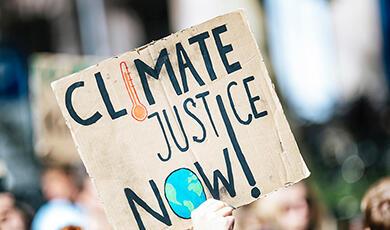Where Is Globalisation Headed? A Supply Chain View
Share
- Details
- Text
- Audio
- Downloads
- Extra Reading
The conflict in Ukraine – and earlier events like Brexit - led prominent asset managers such as BlackRock to declare the “end of globalisation.” Where is globalisation headed?
This talk will take a supply chain perspective on globalisation: why we buy from or sell to far off places and build global supply chains to get the goods from raw material suppliers to manufacturers, and eventually to consumers. And it will look at why globalisation is under threat – besides geopolitics, the supply chain is complicated by factors including its carbon footprint and modern slavery. While it is hard to imagine the end of globalisation, what does the future hold?
Download Text
Where is Globalisation Headed? A Supply Chain View
Professor ManMohan S. Sodhi
6th June 2022
Introduction
The conflict in Ukraine – and earlier events like Brexit - led prominent asset managers such as BlackRock to declare the “end of globalisation.” Where is globalisation headed? This talk takes a supply chain perspective on globalisation: why we buy from or sell to far-off places and build global supply chains to get the goods from raw material suppliers to manufacturers and consumers. And it will look at why globalisation is under threat – besides geopolitics, the supply chain is complicated by factors including its carbon footprint and modern slavery. While it is hard to imagine the end of globalisation, what does the future hold? In this talk, I will discuss: (1) Why do we buy from or sell to far-off places and build global supply chains? (2) Why is globalisation under threat? (3) Are we talking about de-globalisation or de-risking globalisation? (4) What does the future hold for globalisation?
De-globalisation
Larry Fink’s letter of March 24, 2022, as Chairman of BlackRock with $10 trillion in assets in January 2022, got much attention in the press as a turning point in globalisation. He wrote, “The Russian invasion of Ukraine has put an end to the globalisation we have experienced over the last three decades.” He explained it as:
“Russia’s aggression in Ukraine and its subsequent decoupling from the global economy [because of the “economic war” on Russia, as he put it] is going to prompt companies and governments worldwide to re-evaluate their dependencies and re-analyze their manufacturing and assembly footprints, something that Covid had already spurred many to start doing.”
Companies “re-analyzing their manufacturing and assembly footprints” is evidenced in many mentions of near-shoring, on-shoring, and reshoring in companies’ earnings calls and investor conferences (Fig. 1).
The Costs of Globalisation
Globalisation involves increasing trade – and thus economic benefit – between countries and companies in different countries, particularly those far away. Imports across the globe increased some 13 times (not accounting for inflation) from $1.4 trillion in 1990 to $18.3 trillion in 2019. These definitions pertain specifically to trade, even though globalisation, in general, can span many other themes. Offshoring fits this view. Correspondingly, de-globalisation reduces such trade; near-shoring, onshoring, and reshoring bring operations closer to the home country. Supply chains are how raw materials, components, semi-finished goods, and finished goods move from one company or country to another.
Globalisation has faced several challenges recently:
- The growing perception of “strategic rivalry” between the US (and perhaps the west in general) with China – “the world’s factory”
- Covid-19, which jammed up global supply chains and continues to do so
- The Russian invasion of Ukraine and the “economic war” by the west on Russia.
However, these are only continuing the challenges over the decades from 1990 to 2020 that could symbolize globalisation. While globalisation has had tremendous economic benefits worldwide, more than half -- some 52% using GDP at constant 2015 dollars -- of the global increase in GDP from 1990 to 2020 went to just two countries: China and the US. Some 80% went to just 15 countries and 90% to only 30 countries. Thus, the benefits of globalisation have not been to the globe uniformly.
Although many people and countries across the globe did not benefit, they still have had to pay the price of globalisation in at least three ways. (1) Global CO2 emissions have grown. While the US swapped its growth in emissions with China, emissions have increased across many countries. Overall, global CO2 emissions have gone up nearly 70% from 1990 to 2020, with emissions from shipping more than doubling. (2) Climate-related disasters have also affected hundreds of millions of people in some years, particularly in countries that have not benefited much from globalisation. Still, countries that have benefited have paid the price in damage from climate-related natural disasters. (3) Modern slavery now claims tens of millions of people across the globe, and this is only what we know about. As of 2016, the International Labour Organization estimated 40.3 million enslaved people, with 71% of these females and some 16 million working in supply chains.
Yet, globalisation continued, led by companies and countries that benefited. From a supply chain perspective, globalisation grows because companies’ supply chains get longer and broader, cutting across more countries over time. From the supply side, companies face make-or-buy decisions. If they buy, they have to buy locally or from afar from a supplier in a country with lower cost or higher capability. The supplier has the same decision to make in turn. And, if the company wants to ‘make,’ it could make it in the home country or some other. On the demand side, any company wishing to grow seeks new markets, and when the home market is exhausted, looking to distant countries is obvious.
Supply chains get longer, as they did over the 1990-2020 period, creating the threat of more disruptions and the bullwhip effect instability. Longer supply chains are more fragile -- the more links that can break, the higher the chance some link would, thus disrupting the flow of goods. The bullwhip effect – also called the Forrester effect – refers to the amplification in the variability of orders as you get farther away from the handle held by the consumer (buyer). So, the longer the supply chain from the end customer, the greater the variability in orders upstream. Covid-19-related shortages and longer shipment times led to unavailability of some goods, but then there was oversupply, as we saw in the hits to Walmart and Target stock prices. The bullwhip effect also causes continued instability in the supply chain even when demand and capacity have settled down, so we may continue to experience shortages and oversupply for quite some time yet.
Overall, there are several ‘costs’ of globalisation worldwide, even as exports (or imports) worldwide went up some 13 times over the 1990-2020 period:
- Growing inequality across countries
- Growing inequality within countries, particularly low-cost countries supplying more prosperous economies
- Countries are getting poorer by exporting low-value add goods (minerals or agricultural produce) and importing high-value-added items (e.g., electronics and weapon systems)
- Growing damage and threat to the environment, leading to climate change
- Increasing problems of social sustainability
- More economic and non-economic migration.
Where is Globalisation Headed?
Globalisation has benefits and costs. We saw earlier that those who benefit from it and those who pay the price are not the same companies or the same countries. Those who benefit don’t have an incentive to de-globalize, and those who pay the costs, don’t have a say.
Globalisation also has risks, which affect both those who benefit and those who pay the price. Let’s distinguish between de-globalisation and de-risking globalisation first. De-globalisation, as mentioned before, means reduced global trade, with trade within the country or only with nearby countries. De-risking globalisation means reducing dependencies on any country – or currency – and hence the risk associated with non-delivery.
Companies (and countries) can de-risking supply chains in several ways:
- Regionalize supply chains: sell anywhere in the world but buy raw materials and produce within the same region
- Onshore or near-shore assembly (low value-added closer to home)
- Diversify sources: Reduce dependency on any one country by creating multiple dependencies.
- Segment your supply chains by product: Create separate supply chains for different products.
However, all these can result in the supply chain becoming even more global. Reducing risk means either making yourself or buying from several unreliable suppliers, so you are not dependent on any one of them.
Thus, we face the paradox that seeking to “end globalisation” can only lead to more globalisation: Those who benefit (disproportionately) will seek more globalisation; those who pay the price (disproportionately) will have even less to say on the matter; and those who benefit will seek to de-risk, which will also increase globalisation.
BlackRock and the End of Globalisation
Did Larry Fink really mean the end of globalisation? No, recall from the quote earlier that he said, “the end of the globalisation we have experienced,” not globalisation altogether. So, we can interpret his call also as a change in globalisation – with de-risking, not de-globalisation. We can expect the “new” globalisation to be more efficient – remember, supply chains grow longer for this reason – and (hopefully) with less risk.
Indeed, the flow of money, particularly across borders, is the last bastion of inefficiency in global supply chains. Indeed, as Larry Fink said in the same letter (March 2022):
A global digital payment system…can enhance the settlement of international transactions …. [and] bring down costs of cross-border payments…BlackRock is studying digital currencies, stablecoins, and the underlying technologies.
So, BlackRock is investing in efforts to make globalisation more efficient, not predicting its end. Fink’s call is about de-risking, not de-globalisation.
What Governments Need to Do
While businesses figure out how to benefit while de-risking globalisation, governments should seek to reduce the costs we listed earlier: (1) Growing inequality across countries; (2) growing inequality within countries; (3) countries exporting low-value add goods and importing high-value-added items; (4) growing damage and threat to the environment; (5) social unsustainability; (6) more migration; and many others.
First, governments must work towards lowering the barriers to trade across countries to decrease frictional costs and reduce volatility. Here are some ways:
- Free trade agreements
- Digital solutions for international trade
- Make cross-country payments more efficient
- Support government-backed digital currencies
- Seek to ease geopolitical tensions.
Of these, the last one could, for instance, raise questions about reversing Brexit, while the EU could consider swapping out freedom of movement of people within the EU for that of greater freedom of goods. Other global tensions should also be reduced rather than exacerbated.
Second, governments must develop or refine existing industrial policies for development and robustness. They need to consider exporting more value-added items if they are to benefit from globalisation or face continuing marginalization. For this, they would have to build within-country capability, including investment in education. Governments also have to consider importing less value-added items, whether importing fewer such items or, more usefully, adding more value within the country. And reducing dependence on any one currency is now imperative.
Third, governments must require large companies to report more extensively on such things as:
- The level of risk they are aware of and efforts they are making towards de-risking the supply chain
- Transparency of supply chains (environmental and social sustainability)
- Level of attainment of the 17 UN Sustainable Development Goals in the supply chain (meant to be achieved by 2030).
Finally, governments must support small and medium-sized enterprises. Doing so is not about paying lip service or doing so for charity. The purpose is a more robust economy that is also mildly self-sufficient in critical sectors such as food or medical goods to meet domestic needs for at least a few months, thus helping de-risking large companies and the country. One way to do this is to ensure a more level playing field with the tech giants by developing ‘commons’ – a shared infrastructure for all companies. For example, Open Network Digital Commerce meta-platform in India with access to individuals, small businesses, large businesses, and e-commerce startups. Another idea could be to treat many tech giants as utility companies that provide services like electricity or water providers.
Conclusion
In conclusion, while globalisation has many benefits, it also has costs and risks. Although there have been recent predictions and discussions on the “end of globalisation,” a supply-chain-based argument leads us to the paradoxical conclusion that efforts to “end globalisation we have experienced” in the past three decades can only lead to more globalisation. We will globalize even further, whether we are talking of greater efficiency or lower risk through reduced dependency on Country A or B.
Companies will figure out how to get the benefits of globalisation by achieving more efficient, globalized supply chains with, hopefully, less risk. It is up to governments worldwide to help these companies and figure out how to reduce the costs of globalisation. Any government will need to (1) lower barriers to trade with geopolitical and digital solutions, (2) develop an industrial policy for development and robustness, (3) require companies to report more, especially on the attainment of UNSDG goals, and (4) support SMEs, particularly in critical sectors to increase (mild)self-sufficiency and thus de-risk the economy as well.
© Professor Sodhi, 2022
References & Further Reading
Sodhi, M. and Tang, C. 2021. Rethinking industry’s role in a national emergency, May, MIT Sloan Management Review
Chopra, S., Sodhi, M. and Lücker, F. (2021), Achieving supply chain efficiency and resilience by using multi-level commons. Decision Sciences, 52: 817-832.
Papoutsi, A. and Sodhi, M. (2020). Does disclosure in sustainability reports indicate corporate sustainability performance? Jnl Cleaner Production
Sodhi, M. and Tang, C.. 2019. Research opportunities in supply chain transparency, POM, 28(12):2946-2959
Sodhi, M. and Tang, C. 2017. Supply chains built for speed and customization, MIT Sloan Mgmt Review, June
Sodhi, M. 2016. Natural disasters, the economy and population vulnerability as a vicious cycle with exogenous hazards, Journal of Operations Management, 45:101–113.
Sodhi, M. 2015. Conceptualizing social responsibility in operations via stakeholder resource-based view, POM.
Chopra, S. and Sodhi, M. 2014. Reducing the risk of supply chain disruptions, (w/Sunil Chopra), MIT Sloan Management Review. Spring 2014. http://sloanreview.mit.edu/article/reducing-the-risk-of-supply-chain-disruptions/
Sodhi, M. and Tang, C. 2013. Strategies and tactics of Chinese contract manufacturers and western OEMs (2001–2011), IJPE 146 (2013) 14–24
Sodhi, M. and Tang, C. 2012. Managing supply chain risk, with C. Tang, Springer, New York.
References & Further Reading
Sodhi, M. and Tang, C. 2021. Rethinking industry’s role in a national emergency, May, MIT Sloan Management Review
Chopra, S., Sodhi, M. and Lücker, F. (2021), Achieving supply chain efficiency and resilience by using multi-level commons. Decision Sciences, 52: 817-832.
Papoutsi, A. and Sodhi, M. (2020). Does disclosure in sustainability reports indicate corporate sustainability performance? Jnl Cleaner Production
Sodhi, M. and Tang, C.. 2019. Research opportunities in supply chain transparency, POM, 28(12):2946-2959
Sodhi, M. and Tang, C. 2017. Supply chains built for speed and customization, MIT Sloan Mgmt Review, June
Sodhi, M. 2016. Natural disasters, the economy and population vulnerability as a vicious cycle with exogenous hazards, Journal of Operations Management, 45:101–113.
Sodhi, M. 2015. Conceptualizing social responsibility in operations via stakeholder resource-based view, POM.
Chopra, S. and Sodhi, M. 2014. Reducing the risk of supply chain disruptions, (w/Sunil Chopra), MIT Sloan Management Review. Spring 2014. http://sloanreview.mit.edu/article/reducing-the-risk-of-supply-chain-disruptions/
Sodhi, M. and Tang, C. 2013. Strategies and tactics of Chinese contract manufacturers and western OEMs (2001–2011), IJPE 146 (2013) 14–24
Sodhi, M. and Tang, C. 2012. Managing supply chain risk, with C. Tang, Springer, New York.
This event was on Mon, 06 Jun 2022
Support Gresham
Gresham College has offered an outstanding education to the public free of charge for over 400 years. Today, Gresham College plays an important role in fostering a love of learning and a greater understanding of ourselves and the world around us. Your donation will help to widen our reach and to broaden our audience, allowing more people to benefit from a high-quality education from some of the brightest minds.


 Login
Login





